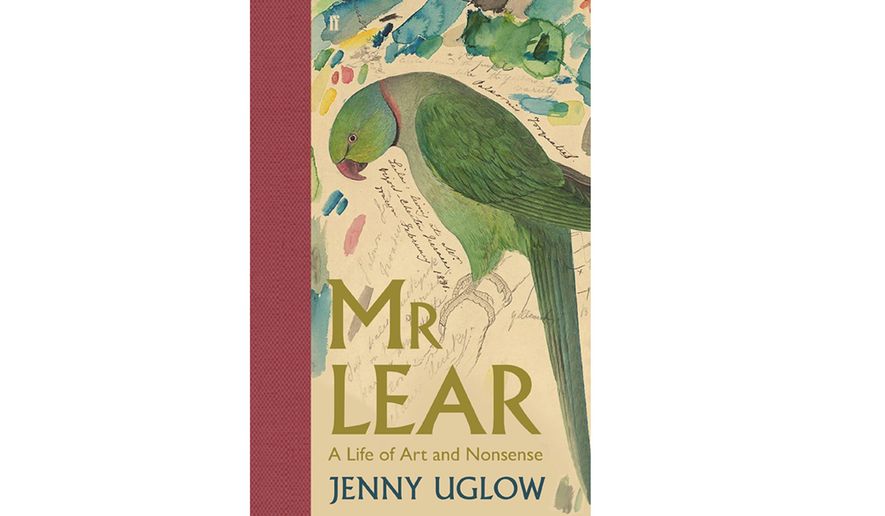OPINION:
MR. LEAR: A LIFE OF ART AND NONSENSE
By Jenny Uglow
Farrar, Strauss and Giroux, $45, 608 pages
Any child who was lucky enough to grow up with Edward Lear’s “Book of Nonsense” experienced the delight at discovering a world of linguistic word play, full of oddities and whimsy, thrown together as if by happy accident. In 2012, a poll in the United Kingdom voted “The Owl and the Pussy-Cat” (composed in 1867) as the nation’s favorite poem. Now, one of Britain’s most celebrated biographers has written the life of Edward Lear portrayed in all of his complex glory.
What emerges are several Lears. Lear, the talented painter of birds and beasts. The landscape artist. The romantic world traveler. The Lear of astonishing limerick and song. The Lear of epilepsy, depression and loneliness.
Edward Lear, born in 1812, was the 20th of 21 children, the youngest to survive. Bullied in school, he loved reading myths and poetry, and was drawn to botany, birds and animals. His paintings of macaws, toucans and parrots, which he observed from live specimens at the London Zoo and subsequently published in 1830-1832 at age 18, glow with color and inquisitive intelligence; he became known as one of the finest natural history painters of his day, admired by his friend, John James Audobon.
His landscapes have been recognized for their skill and beauty. He would sit down, push up his spectacles and draw mountain ranges and villages so quickly and accurately bystanders were left awe-struck. Among Lear’s admirers was Queen Victoria, who asked him to give her drawing lessons in sessions squeezed in between government business and visits to the nursery. His most famous gaffe occurred one day at Buckingham Palace, when he asked Her Majesty: “Oh! How did you get all these beautiful things?” To which she replied mildly, “I inherited them, Mr. Lear.”
He was in great demand, contributing illustrations for accounts to expeditions. Lear saw himself as a Romantic wanderer and world traveler, and went to Italy, Greece, Albania, Egypt and India, recounting his adventures in travel journals published throughout the 1840s and ‘50s. He was a faithful correspondent (“Letters are the only solace of my life at present,” he wrote to a friend, “except sardines and omelettes”), sprinkling them with self-portraits of a fat man with a bushy beard. Along the way he struck up a friendship with Alfred, Lord Tennyson, and became the confidante of his wife, Emily. In 1853 he set Tennyson’s poetry to music.
Beneath Lear’s amiable geniality and good cheer, was the constant nagging worry for his future: “money, loneliness, travel, his career as an artist.” He was nervous at seeming to sponge on patrons, yet necessity drove him to send out reminders that paintings they had admired were for sale. His private diaries, while circumspect, revealed homosexual longings. He was forever the outsider, “lonely and wild.”
At the same time he was drawn to intelligent, decorative women, yearning for his own “Jumbly Girl with her sky-blue hands and sea-green hair.” His attempts at companionship with either sex were unsuccessful. He suffered from epileptic seizures, bronchitis, asthma and depression, which he called “the Morbids.” Although he recognized he would live most of his life alone, he enjoyed a wide circle of friends who invited him to dinner, concerts and garden parties, who warmly appreciated his “life-religion” based on ethics and loving-kindness, the teasing and the “absurd and sweet stories” he wrote for their children.
These gifts became the basis for his books of nonsense, limericks and alphabets, published between 1861 and 1877. “Lear’s alphabets, which he wrote to entertain, were also serious,” writes the author. “Letters were tools to open a door for children into the land of language, rhyme, story and feeling; the world of imagination.” As a child she, too, had “loved the unexpected rhymes, the exotic and ordinary places and the strange words” that demand to be read aloud. As his biographer, Mrs. Uglow expertly leads us into the work with renewed appreciation. Her handling of the material is never precious. Instead it is vivid and deft, so much so that when she describes his death in 1888, one feels a sense of real loss that the story has come to an end.
Last, and this is no small matter: Just as in an earlier work by this same author (“Nature’s Engraver: A Life of Thomas Bewick”) this is a beautifully crafted book. The quality of paper is crisp, the placement and reproduction of the numerous illustrations sharp. Throughout you get a distinct sense of the biographer’s enthusiasm for her subject and an eagerness to share, making “Mr. Lear: A Life of Art and Nonsense” a pleasure to hold, to savor, to read — and to treasure.
• Marion Elizabeth Rodgers is the author of “Mencken: The American Iconoclast.”




Please read our comment policy before commenting.